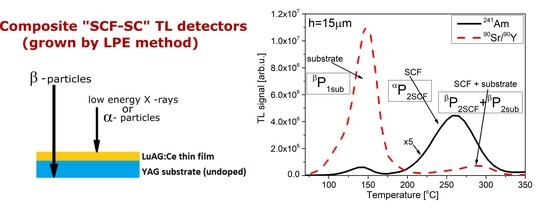Application of the LPE-Grown LuAG: Ce Film/YAG Crystal Composite Thermoluminescence Detector for Distinguishing the Components of the Mixed Radiation Field
Abstract
1. Introduction
2. Materials and Methods
2.1. Materials under Study
2.2. Irradiation Sources
2.3. TL Glow-Curve Measurements and TL Emission Spectra Measurements
3. Results
3.1. YAG Substrate
3.2. 241Am Irradiation
3.3. X-Rays and β-Particle Irradiation
3.4. TL Glow-Curve Deconvolution
3.5. Mixed Radiation Field
4. Conclusions
Author Contributions
Funding
Institutional Review Board Statement
Informed Consent Statement
Data Availability Statement
Conflicts of Interest
References
- Globus, M.; Grinyov, B.; Ratner, M.; Tarasov, V.; Lyubinskiy, V.; Zorenko, Y.; Konstankevych, I. New type of scintillation phoswich detectors for biological, medical and radiation monitoring applications. In Proceedings of the IEEE Nuclear Science Symposium Conference Record, Norfolk, VA, USA, 10–16 November 2002; Volume 1, pp. 352–356. [Google Scholar]
- Chapuran, T.; Balamuth, D.P.; Arrison, J.W.; Görres, J. Channel selection for in-beam spectroscopy using a 4π phoswich array. Nucl. Instrum. Methods Phys. Res. A 1988, 272, 767–784. [Google Scholar] [CrossRef]
- Seigel, J.; Vaquero, J.J.; Gandler, W.R. Depth identification accuracy of a three layer phoswich PET detector module. IEEE Trans. Nucl. Sci. 1999, 46, 485–490. [Google Scholar]
- Saoudi, A.; Lecompte, R. A novel APD-based detector module for multi-modality PET/SPECT/CT scanners. IEEE Trans. Nucl. Sci. 1999, 46, 479–484. [Google Scholar] [CrossRef]
- Ryshikov, V. Studies of cadmium tungstate single crystals for detection of thermal neutrons. In Proceedings of the International Conference on Inorganic Scintillators and Their Applications, Shanghai, China, 22–25 September 1997; pp. 157–160. [Google Scholar]
- Koch, A.; Raven, C. Scintillators for high-resolution x-ray imaging. In Proceedings of the International Conference on Inorganic Scintillators and Their Applications, Shanghai, China, 22–25 September 1997; pp. 28–31. [Google Scholar]
- Koch, A.; Cloetens, P.; Ludwig, W.; Labiche, J.; Ferrand, B. Reading thin-film scintillators with optical microscopes for X-ray imaging. In Proceedings of the 5th International Conference Inorganic Scintillators and Their Applications, Moscow, Russia, 16–20 August 1999; pp. 157–166. [Google Scholar]
- Dujardin, C.; Murillo, A.G.; Leluyer, C.; Gamier, N.; Mugnier, J.; Pedrini, C.; Ko, J.M.; Lebbou, K.; Fukuda, T.; Belsky, A. Interest of thin scintillating films. In Proceedings of the XVI International Conference Inorganic Scintillators and Their Use in Scientific and Industrial Applications, Chamonix, France, 16–21 September 2001. [Google Scholar]
- Dorenbos, P.; van Eijk, C.W.E.; van Loef, E.; Globus, M.; Grinyov, B.; Ratner, M.; Tarasov, V.; Zorenko, Y. Heavy oxyde scintillators: Bulk crystals and thin films for radiation monitoring of environment and biological objects. In Proceedings of the 5th International Conference Inorganic Scintillators and Their Applications, Moscow, Russia, 16–20 August 1999; pp. 577–582. [Google Scholar]
- Martin, T.; Koch, A. Recent developments in X-ray imaging with micrometer spatial resolution. J. Synchrotron Radiat. 2006, 13, 180–194. [Google Scholar] [CrossRef]
- Riva, F.; Douissard, P.-A.; Martin, T.; Carla, F.; Zorenko, Y.V.; Dujardin, C. Epitaxial growth of gadolinium and lutetium-based aluminum perovskites thin film for X-rays micro-imaging applications. CrystEngComm 2016, 18, 608–615. [Google Scholar] [CrossRef]
- Gerasymov, I.; Nepokupnaya, T.; Boyarintsev, A.; Sidletskiy, O.; Kurtsev, D.; Voloshyna, O.; Trubaieva, O.; Boyarintseva, Y.; Sibilieva, T.; Shaposhnyk, A.; et al. GAGG:Ce composite scintillator for X-ray imaging. Opt. Mater. 2020, 109, 110305. [Google Scholar] [CrossRef]
- Prusa, P.; Kucera, M.; Mares, J.A.; Hanus, M.; Beitlerova, A.; Onderisinova, Z.; Nikl, M. Scintillation properties of the Ce-doped multicomponent garnet epitaxial films. Opt. Mater. 2013, 35, 2444–2448. [Google Scholar] [CrossRef]
- Zorenko, Y.; Novosad, S.; Pashkovskii, M.; Lyskovich, A.; Savitskii, V.; Batenchuk, M.; Nazar, I.; Gorbenko, V. Epitaxial structures of garnets as scintillation detectors of ionizing radiation. J. Appl. Spectrosc. 1990, 52, 645–649. [Google Scholar] [CrossRef]
- Witkiewicz-Lukaszek, S.; Gorbenko, V.; Zorenko, T.; Paprocki, K.; Sidletskiy, O.; Gerasymov, I.; Mares, J.A.; Kucerkova, R.; Nikl, M.; Zorenko, Y. Composite scintillators based on the crystals and single crystalline films of LuAG garnet doped with Ce3+, Pr3+ and Sc3+ ions. Opt. Mater. 2018, 84, 593–599. [Google Scholar] [CrossRef]
- Witkiewicz-Lukaszek, S.; Gorbenko, V.; Zorenko, T.; Zorenko, Y.; Gieszczyk, W.; Mrozik, A.; Bilski, P. Composite thermoluminescence detectors based on the Ce3+ doped LuAG/YAG and YAG/LuAG epitaxial structures. Radiat. Meas. 2019, 128, 106124. [Google Scholar] [CrossRef]
- Ferrand, B.; Chambaz, B.; Couchaud, M. Liquid phase epitaxy: A versatile technique for the development of miniature optical components in single crystal dielectric media. Opt. Mater. 1999, 11, 101–114. [Google Scholar] [CrossRef]
- Horowitz, Y.S. Thermoluminescence and Thermoluminescent Dosimetry; CRC Press: Boca Raton, FL, USA, 1983. [Google Scholar]
- McKeever, S.W.S.; Moscovitch, M.; Townsend, P.D. Thermoluminescence Dosimetry Materials: Properties and Uses; Nuclear Technology Publishing: Ashford, UK, 1995. [Google Scholar]
- McKeever, S.W.S.; Akserlod, M.S.; Colyott, L.E. Characteristation of Al2O3 for use in thermally and opically stimulated luminescence doismetry. Radiat. Prot. Dosim. 1999, 84, 163–168. [Google Scholar] [CrossRef]
- Akserlod, M.S.; Lucas, A.C.; Polf, J.C.; McKeever, S.W.S. Optically stiumlated luminescence of Al2O3. Radiat. Meas. 1998, 29, 391–399. [Google Scholar]
- Winiecki, J.; Witkiewicz-Łukaszek, S.; Michalska, P.; Jakubowski, S.; Nizhankovskiy, S.; Zorenko, Y. Basic characteristics of dose distributions of photons beam for radiotherapeutic applications using YAG:Ce crystal detectors. Materials 2022, 15, 7861. [Google Scholar] [CrossRef] [PubMed]
- Markovsky, A.; Gorbenko, V.; Yokosawa, T.; Will, J.; Spiecker, E.; Batentschuk, M.; Elia, J.; Fedorov, A.; Pakuła, M.; Kaczmarek, M.; et al. Structural, luminescence and photoconversion properties of Lu3Al5O12:Ce single crystalline film phosphors for WLED application. J. Alloys Compd. 2022, 929, 167159. [Google Scholar] [CrossRef]
- Bilski, P.; Marczewska, B. Fluorescent detection of single tracks of alpha particles using lithium fluoride crystals. Nucl. Instr. Meth. B 2017, 392, 41–45. [Google Scholar] [CrossRef]
- Budzanowski, M.; Olko, P.; Marczewska, B.; Czopyk, Ł.; Słapa, M.; Stras, W.; Traczyk, M.; Talejko, M. Dose distribution around a needle-like anode X-ray Tube: Dye-film vs. Planar thermoluminescent Detectors. Radiat. Prot. Dosim. 2006, 120, 117–120. [Google Scholar] [CrossRef]
- Słapa, M.; Straś, W.; Traczyk, M.; Dora, J.; Snopek, M.; Gutowski, R.; Drabik, W. X-ray tube with needle-like anode. Nukleonika 2002, 47, 95–99. [Google Scholar]
- Ziegler, J.F.; Ziegler, M.D.; Biersack, J.P. SRIM—The stopping and range of ions in matter. Nucl. Instr. Meth. B 2010, 268, 1818–1823. [Google Scholar] [CrossRef]
- Bos, A.J.J. Theory of thermoluminescence. Radiat. Meas. 2007, 41, S45–S56. [Google Scholar] [CrossRef]
- McKeever, S.W.S. Thermoluminescence of Solids; Cambridge University Press: Cambridge, UK, 1985. [Google Scholar]
- Furetta, C. Handbook of Thermoluminescence; World Scientific Publishing: Singapore, 2003. [Google Scholar]
- Marczewska, B.; Bilski, P.; Czopyk, L.; Olko, P.; Waligórski, M.P.R.; Zapotoczny, S. Two-dimensional thermoluminescence dosimetry using planar detectors and a TL reader with CCD camera readout. Radiat. Prot. Dosim. 2006, 120, 129–132. [Google Scholar] [CrossRef]
- Zorenko, Y.; Zorenko, T.; Voznyak, T. Luminescence centers in Y3Al5O12:La single crystals. J. Phys. Conf. Ser. 2011, 289, 012028. [Google Scholar] [CrossRef]
- Mori, K. Transient colour centres caused by UV light irradiation in yttrium aluminium garnet crystals. Phys. Status Solidi A 1977, 42, 375–384. [Google Scholar] [CrossRef]
- Lupei, A.; Stoicescu, C.; Lupei, V. X-ray and spectral characterization of defects in garnets. J. Cryst. Growth 1997, 177, 207–210. [Google Scholar] [CrossRef]
- Kuklja, C.M. Defects in yttrium aluminium perovskite and garnet crystals: Atomistic study. J. Phys. Condens. Matter 2000, 12, 2953. [Google Scholar] [CrossRef]
- Stanek, D.C.R.; McClellan, K.J.; Levy, M.R.; Milanese, C.; Grimes, R.W. The effect of intrinsic defects on RE3Al5O12 garnet scintillator performance. Nucl. Instrum. Methods Phys. Res. Sect. A Accel. Spectrometers Detect. Assoc. Equip. 2007, 579, 27–30. [Google Scholar] [CrossRef]
- Varney, C.R.; Selim, F.A. Color centers in YAG. AIMS Mater. Sci. 2015, 2, 560–572. [Google Scholar] [CrossRef]
- Feng, X.Q. Anti-site Defects in YAG and LuAG Crystals. J. Inorg. Mater. 2010, 25, 785–794. [Google Scholar] [CrossRef]
- Pujats, G.A.; Springis, M. The F-type centres in YAG crystals. Radiat. Eff. Defects Solids 2001, 155, 65–69. [Google Scholar] [CrossRef]
- Laguta, H.V.; Buryi, M.; Arhipov, P.; Sidletskiy, O.; Laguta, O.; Brik, M.G.; Nikl, M. Oxygen-vacancy donor-electron Center in Y3Al5O12 garnet crystals: Electron paramagnetic resonance and dielectric spectroscopy study. Phys. Rev. B 2020, 101, 024106. [Google Scholar] [CrossRef]
- Blasse, G.; Grabmeier, B.C. Luminescent Materials; Springer: Berlin/Heidelberg, Germany, 1994. [Google Scholar]
- Mrozik, A.; Bilski, P.; Gieszczyk, W.; Zorenko, Y.; Gorbenko, V. Investigations of the influence of Am-241 photons on the measured alpha particle response of luminescent materials. Radiat. Meas. 2020, 134, 106331. [Google Scholar] [CrossRef]

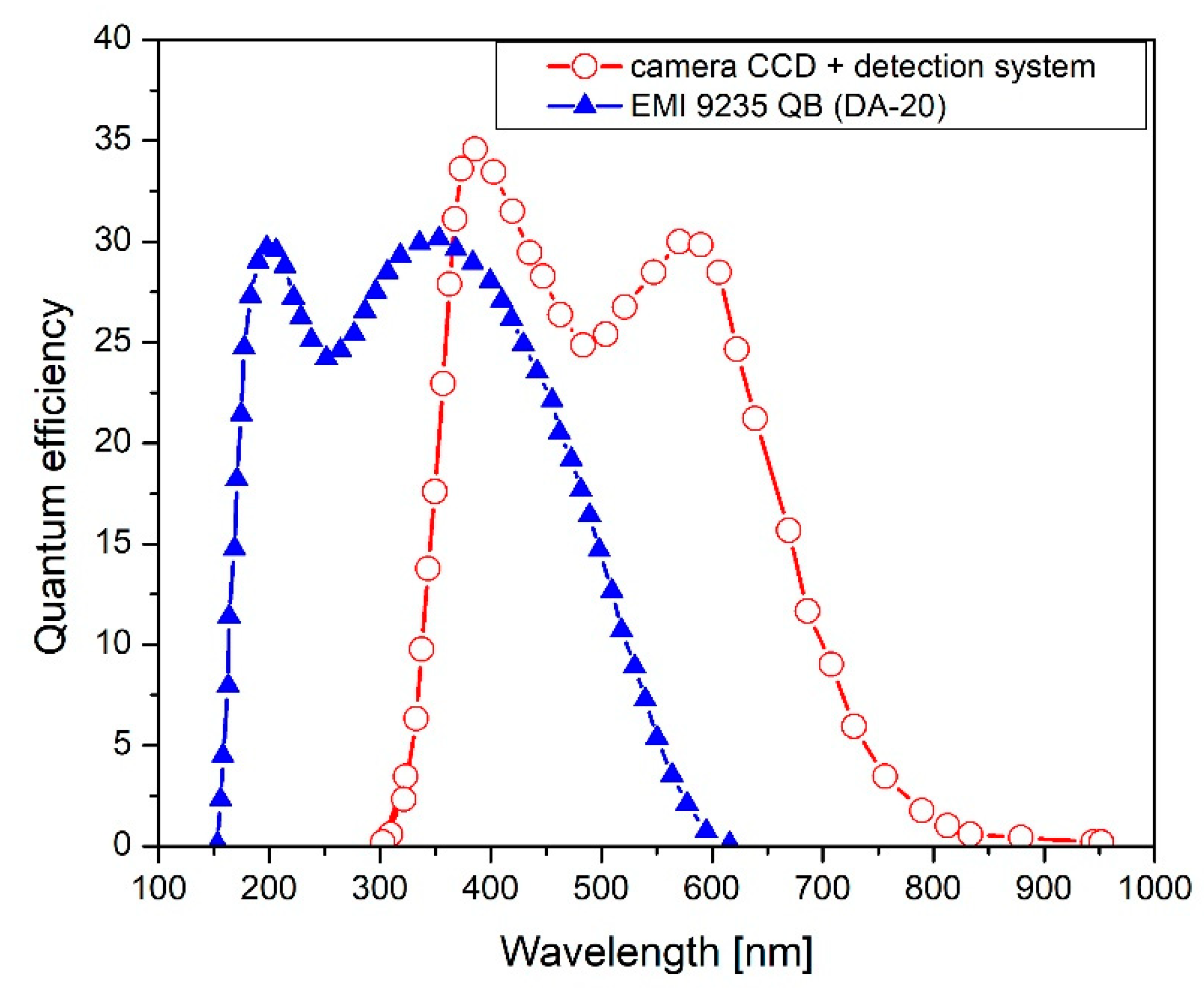
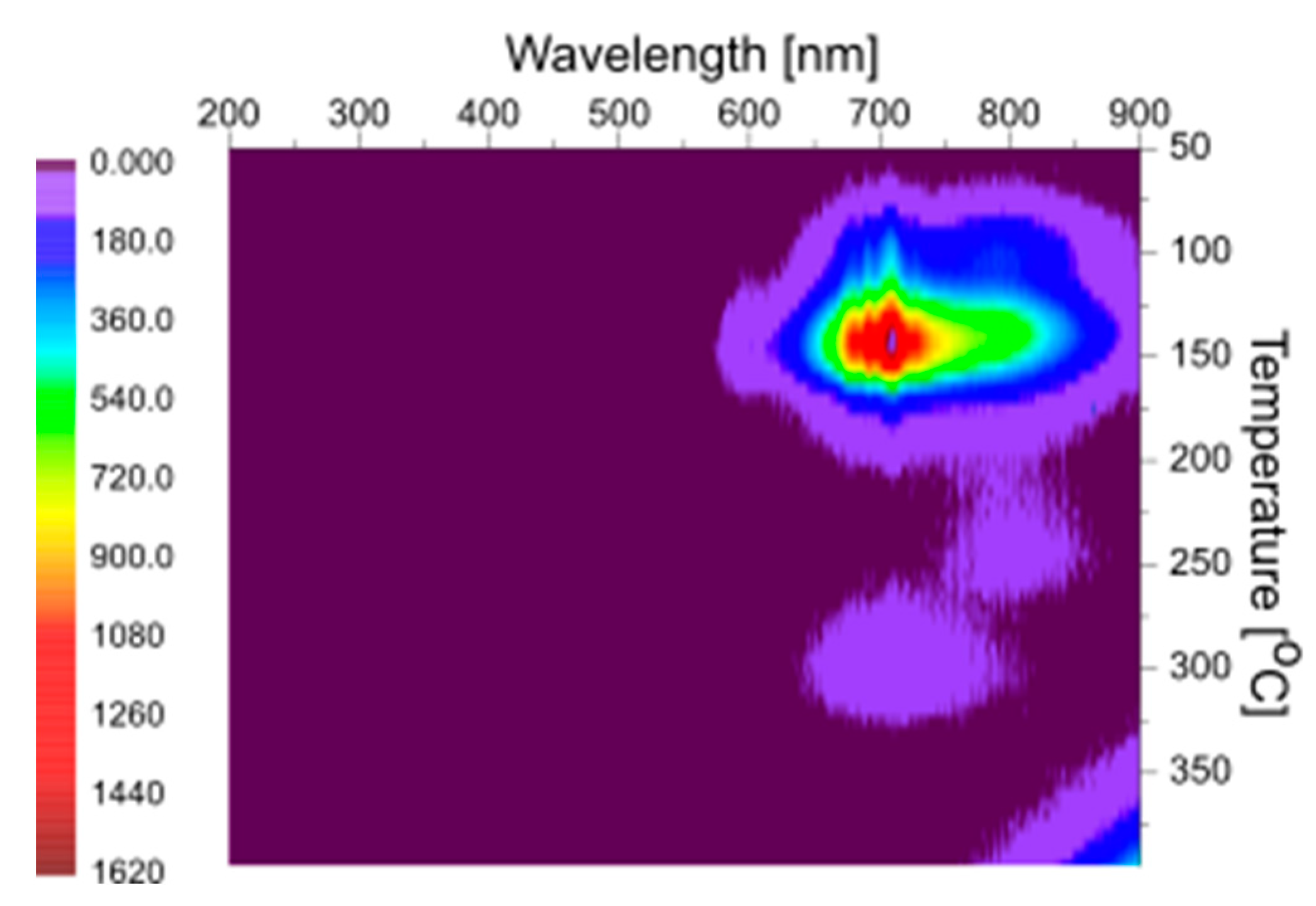
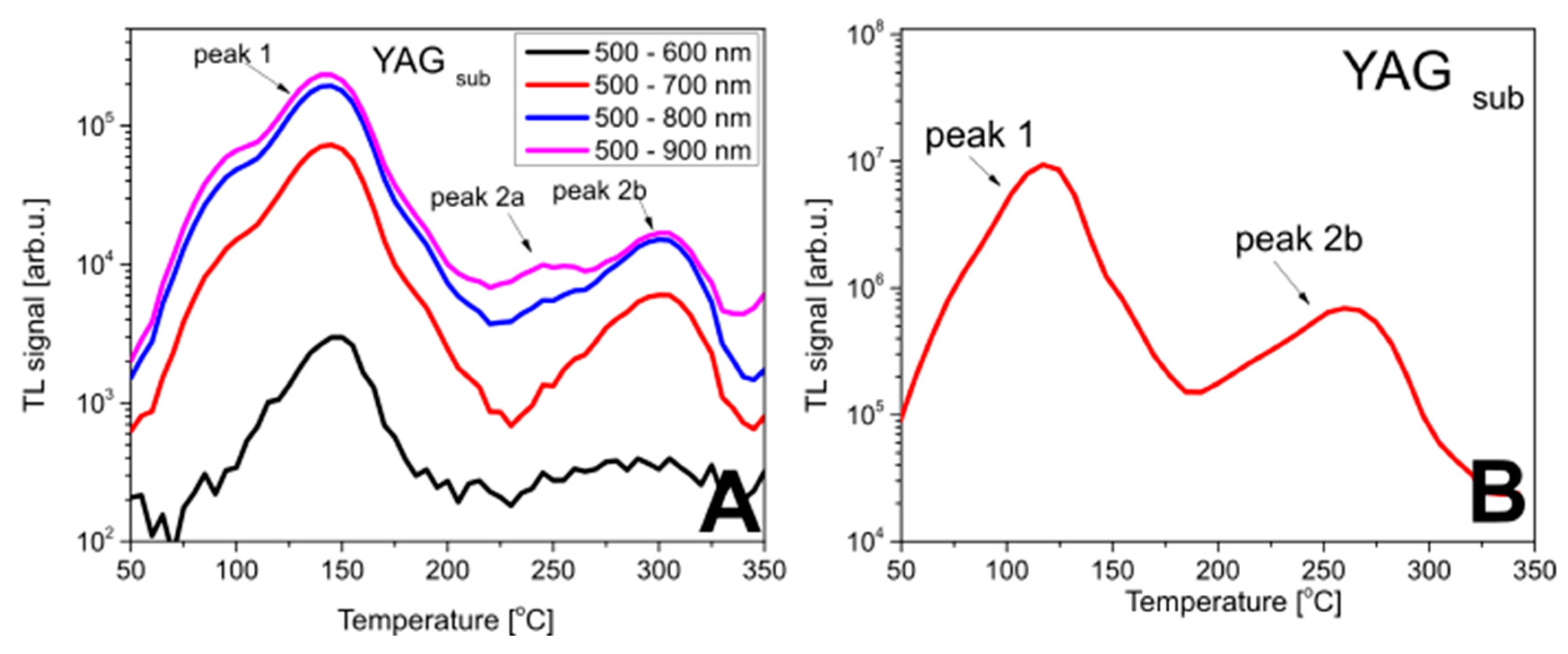


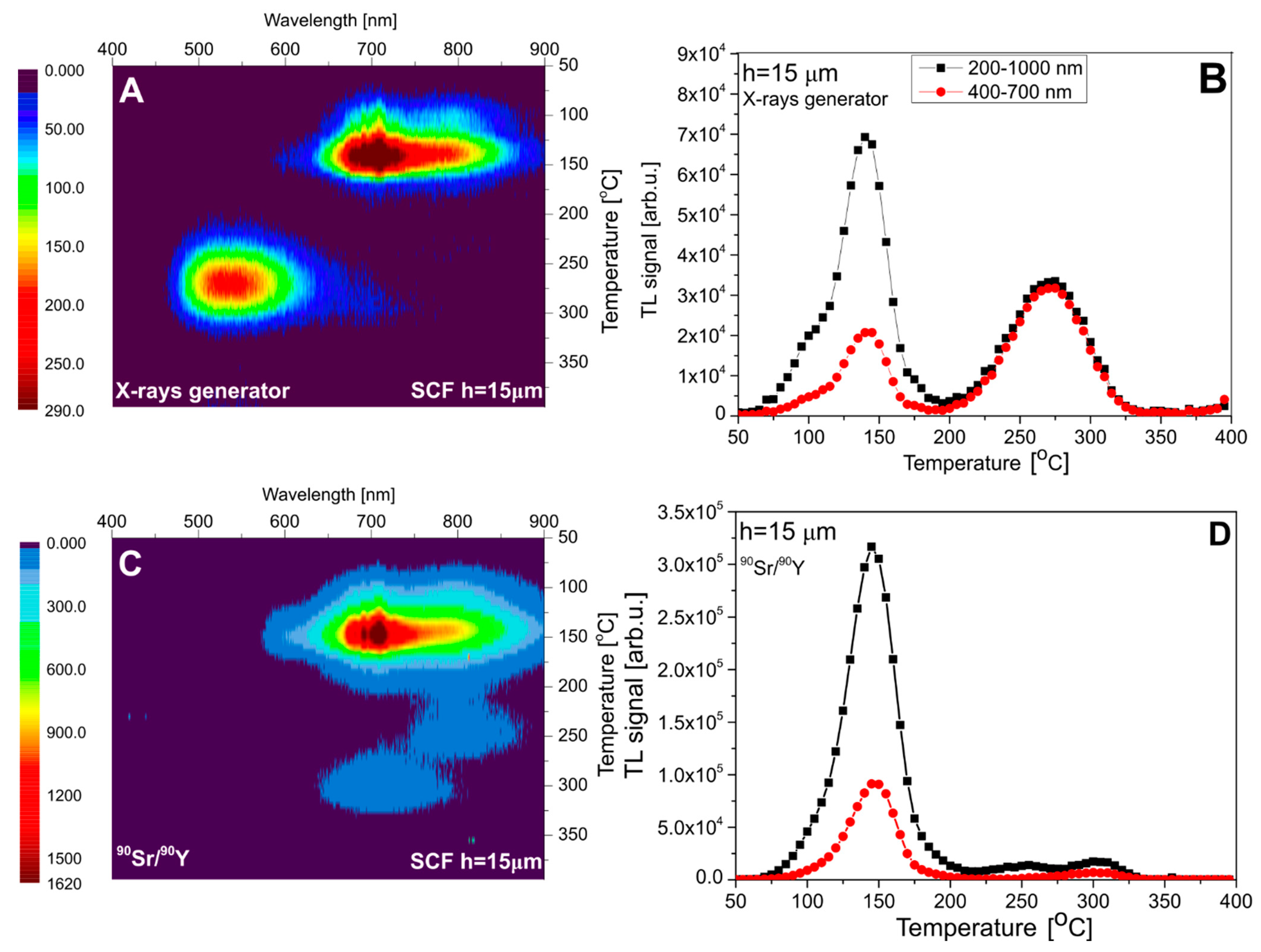
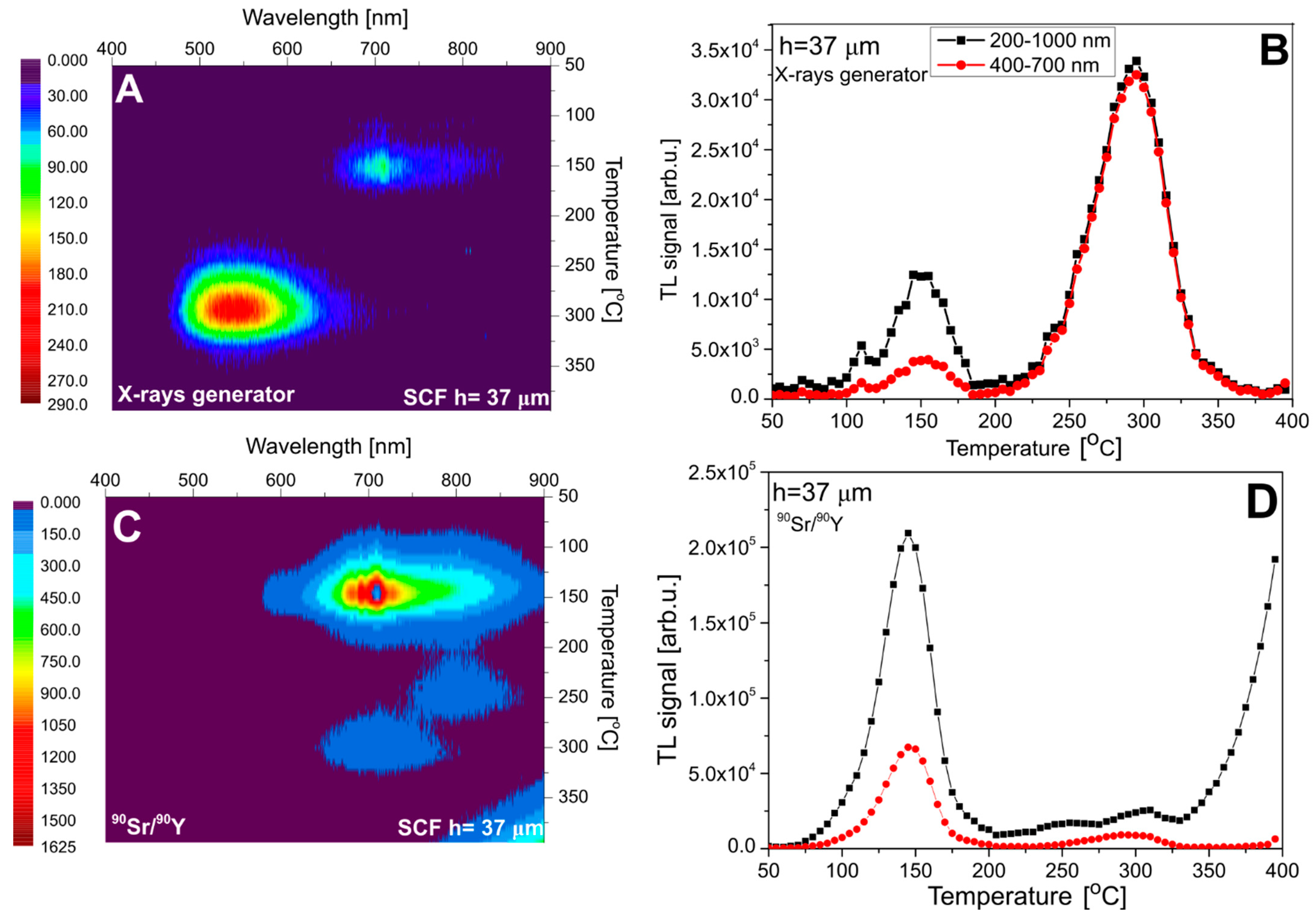
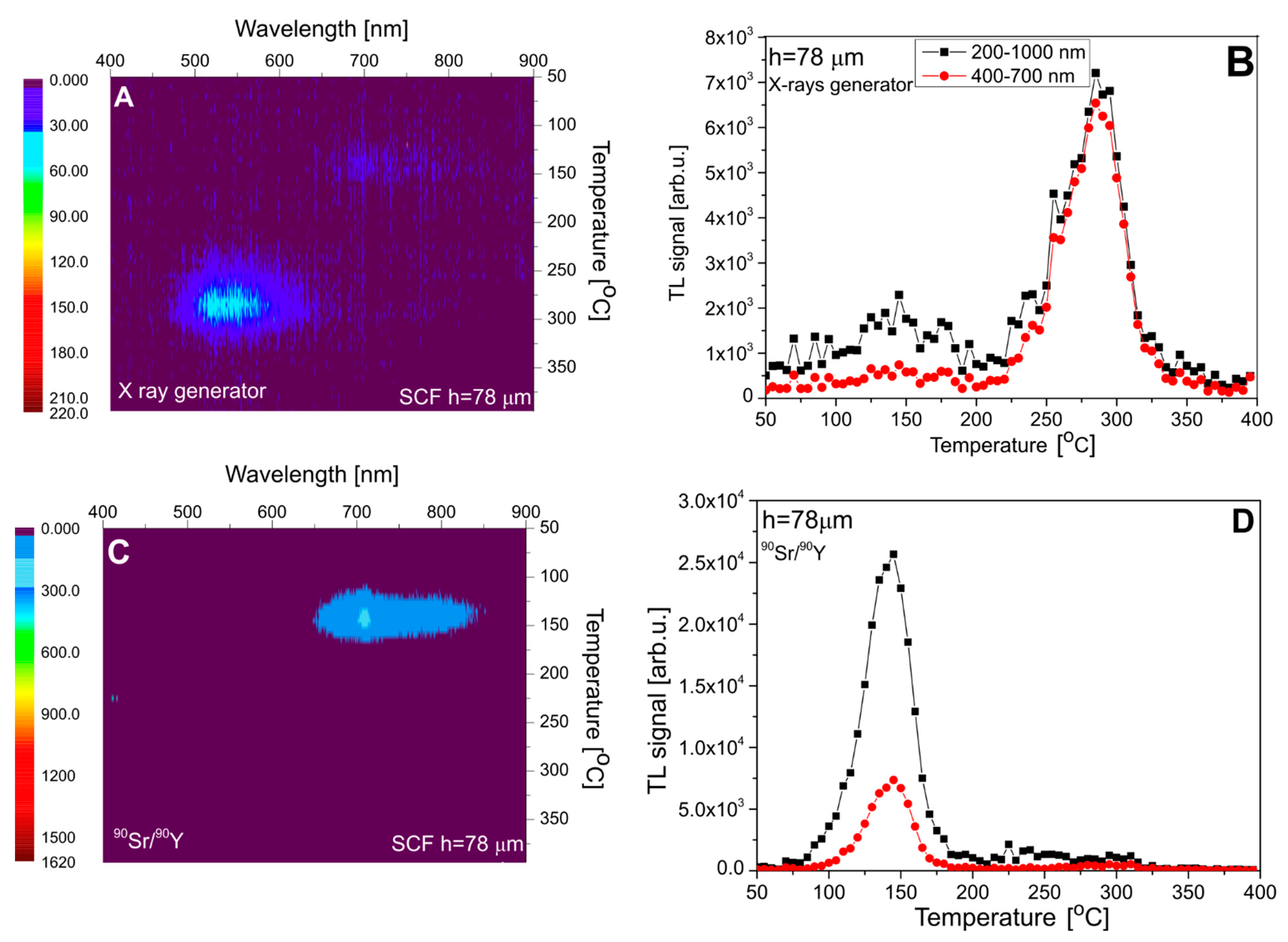
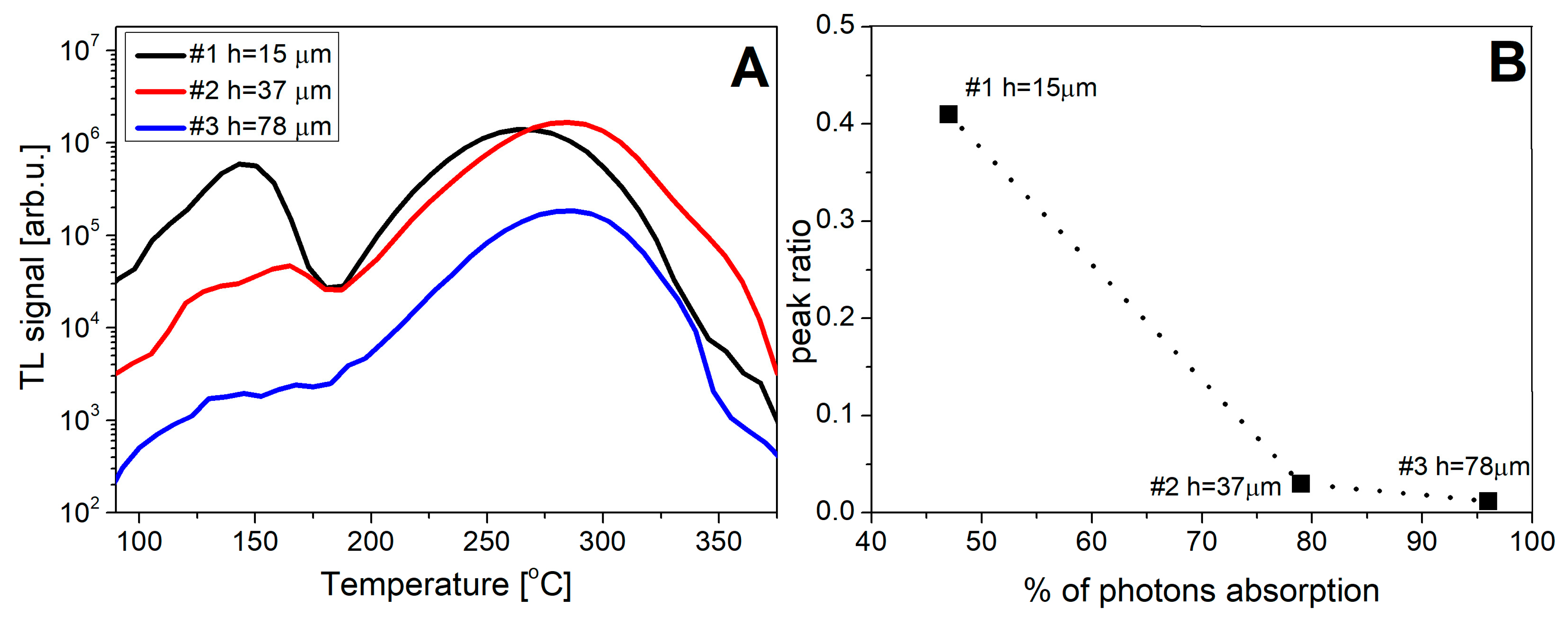
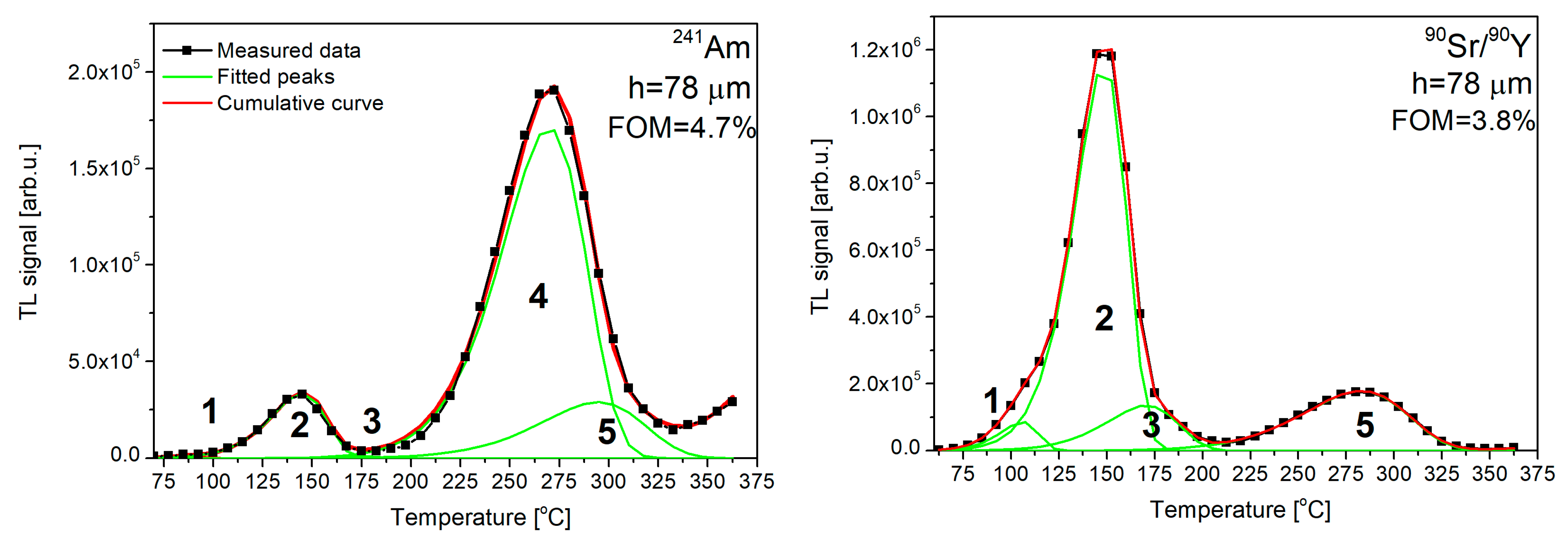


| Sample Number | Material (SCF/SC) | Density of SCF [g/cm3] | Thickness of SCF [µm] | Range of Alpha Particles Energy 3.5 MeV in LuAG [µm] | 10 keV Photon Absorption in LuAG [%] | 60 keV Photon Absorption in LuAG [%] |
|---|---|---|---|---|---|---|
| #1 | LuAG: Ce/YAG | 6.71 | 15 | 7.80 | 47 | 1.5 |
| #2 | 37 | 79 | 3.8 | |||
| #3 | 78 | 96 | 7.8 |
| Peak Number and Origin of the TL Signal: SCF or SC | Temperature [°C] | Wavelength [nm] | ||||||
|---|---|---|---|---|---|---|---|---|
| substrate | #1 h = 15 µm | #2 h = 37 µm | #3 h = 78 µm | substrate | #1 h = 15 µm | #2 h = 37 µm | #3 h = 78 µm | |
| 1 (SC) | 144 | 138 | 144 | 140 | 700 | 702 | 708 | 708 |
| 2a (SC) | 240 | 245 | 240 | - | 800 | 803 | 804 | - |
| 2 (SCF) | - | 268 | 290 | 284 | - | 533 | 538 | 542 |
| 2b (SC) | 300 | 300 | 295 | - | 700 | 711 | 713 | - |
| P1 | P2 | P3 | P4 | P5 | |
|---|---|---|---|---|---|
| 90Sr/90Y, h = 78 µm | |||||
| Tmax [°C] | 105 | 148 | 170 | - | 282 |
| E [eV] | 1.24 | 1.09 | 0.88 | - | 0.94 |
| A | 86,283 | 1,161,109 | 134,947 | - | 178,764 |
| 241Am, h = 78 µm | |||||
| Tmax [°C] | 87 | 143 | 158 | 267 | 296 |
| E [eV] | 1.24 | 1.09 | 1.03 | 1.2 | 1.11 |
| A | 1200 | 29,723 | 2838 | 156,770 | 53,573 |
| Sample Number | Thickness of SCF [µm] | calcΦα [cm−2] | calcDβ [Gy] | calcΦα/refΦα | calcDβ/refDβ |
|---|---|---|---|---|---|
| #1 | 15 | 1.91 × 1011 | 119 | 1.06 | 0.99 |
| #2 | 37 | 1.97 × 1011 | 116 | 1.24 | 0.97 |
| #3 | 78 | 2.41 × 1011 | 119 | 1.53 | 0.99 |
Publisher’s Note: MDPI stays neutral with regard to jurisdictional claims in published maps and institutional affiliations. |
© 2022 by the authors. Licensee MDPI, Basel, Switzerland. This article is an open access article distributed under the terms and conditions of the Creative Commons Attribution (CC BY) license (https://creativecommons.org/licenses/by/4.0/).
Share and Cite
Mrozik, A.; Bilski, P.; Gieszczyk, W.; Kłosowski, M.; Witkiewicz-Łukaszek, S.; Gorbenko, V.; Zorenko, T.; Zorenko, Y. Application of the LPE-Grown LuAG: Ce Film/YAG Crystal Composite Thermoluminescence Detector for Distinguishing the Components of the Mixed Radiation Field. Materials 2022, 15, 8708. https://doi.org/10.3390/ma15248708
Mrozik A, Bilski P, Gieszczyk W, Kłosowski M, Witkiewicz-Łukaszek S, Gorbenko V, Zorenko T, Zorenko Y. Application of the LPE-Grown LuAG: Ce Film/YAG Crystal Composite Thermoluminescence Detector for Distinguishing the Components of the Mixed Radiation Field. Materials. 2022; 15(24):8708. https://doi.org/10.3390/ma15248708
Chicago/Turabian StyleMrozik, Anna, Paweł Bilski, Wojciech Gieszczyk, Mariusz Kłosowski, Sandra Witkiewicz-Łukaszek, Vitaliy Gorbenko, Tetiana Zorenko, and Yuriy Zorenko. 2022. "Application of the LPE-Grown LuAG: Ce Film/YAG Crystal Composite Thermoluminescence Detector for Distinguishing the Components of the Mixed Radiation Field" Materials 15, no. 24: 8708. https://doi.org/10.3390/ma15248708
APA StyleMrozik, A., Bilski, P., Gieszczyk, W., Kłosowski, M., Witkiewicz-Łukaszek, S., Gorbenko, V., Zorenko, T., & Zorenko, Y. (2022). Application of the LPE-Grown LuAG: Ce Film/YAG Crystal Composite Thermoluminescence Detector for Distinguishing the Components of the Mixed Radiation Field. Materials, 15(24), 8708. https://doi.org/10.3390/ma15248708







